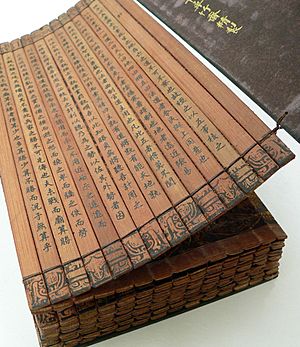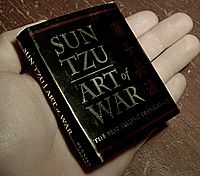The Art of War facts for kids
 |
|
| Author | Sun Tzu (traditional) |
|---|---|
| Country | China |
| Language | Classical Chinese |
| Subject | Military art |
|
Publication date
|
5th century BC |
|
Original text
|
The Art of War at Script error: The function "name_from_code" does not exist. Wikisource |
| Translation | The Art of War at Wikisource |
| The Art of War | |||||||||||||||||||||||||||
|---|---|---|---|---|---|---|---|---|---|---|---|---|---|---|---|---|---|---|---|---|---|---|---|---|---|---|---|
| Traditional Chinese | 孫子兵法 | ||||||||||||||||||||||||||
| Simplified Chinese | 孙子兵法 | ||||||||||||||||||||||||||
| Literal meaning | "Master Sun's Military Methods" | ||||||||||||||||||||||||||
|
|||||||||||||||||||||||||||
The Art of War (Chinese: 孫子兵法; lit. 'Sun Tzu's Military Method') is a very old Chinese book about war. It was written around 500 BC. People believe it was written by a smart military leader named Sun Tzu ("Master Sun").
The book has 13 chapters. Each chapter talks about a different part of warfare. It covers how to plan battles and use smart moves. For nearly 1,500 years, it was a main book in a collection called the Seven Military Classics. This collection was put together by Emperor Shenzong of Song in 1080.
The Art of War is still a very important book about strategy in East Asia. It has also shaped military ideas in Western countries. Today, its ideas are used in many areas outside of war. These include business, sports, and even politics.
The book explains a lot about the Chinese military from the 5th century BC. It covers weapons, weather, and how to lead soldiers. Sun Tzu also said that getting secret information (espionage) is very important in war. His ideas have been used for thousands of years to train military leaders.
The book was first put into French in 1772. The first full English version was published in 1910 by Lionel Giles. Many famous leaders have been inspired by this book. These include Mao Zedong from China, Takeda Shingen from Japan, and generals like Võ Nguyên Giáp, Douglas MacArthur, and Norman Schwarzkopf Jr..
Contents
History of the Book
Who Wrote The Art of War?
The Art of War is traditionally said to be written by an old Chinese general named Sun Tzu. "Sun Tzu" means "Master Sun." People used to think Sun Tzu lived in the 6th century BC. But the oldest parts of The Art of War likely came about 100 years later.
Sima Qian wrote a very old Chinese history book called Records of the Grand Historian. It says that a book about military matters was written by "Sun Wu" from the State of Qi. This book was read by King Helü of Wu. Many people believed this "Sun Wu" was the same Sun Tzu who wrote The Art of War.
The general and poet Cao Cao wrote the earliest known notes on The Art of War in the early 200s AD. He said he edited the book. Over time, different versions of the book appeared in Chinese history records.
Finding the Real Author

Around the 1100s, some Chinese scholars started to wonder if Sun Tzu really existed. This was because he wasn't mentioned in another important history book, Zuo Zhuan. The name "Sun Wu" also didn't show up in any books before Records of the Grand Historian. Some thought "Sun Wu" might have been a made-up name.
In the early 1900s, a writer named Liang Qichao thought the book was written in the 300s BC. He believed it was written by Sun Bin, who was said to be a descendant of Sun Tzu. Sun Bin was a real person and a known military expert.
Then, in 1972, something amazing happened. The Yinqueshan Han slips were found in old tombs in China. These were writings on bamboo slips from the Han Dynasty (206 BC – 220 AD). Among them were two different texts. One was like the Art of War we know, linked to "Sun Tzu." The other was linked to Sun Bin.
This discovery showed there were likely two "Master Sun's Art of War" books. The older text is about one-third the size of the modern book. It is now believed that the earliest The Art of War was finished between 500 and 430 BC.
The 13 Chapters of Strategy
The Art of War is split into 13 chapters. Each chapter focuses on a different part of military strategy.
| Chapter | Title (Common Translation) | What it's About |
|---|---|---|
| I | Laying Plans | This chapter looks at five key things that decide if you win a battle. These are: your moral influence, the weather, the land, your leader, and how you manage things. It teaches you to think carefully before starting any conflict. |
| II | Waging War | This explains how to understand the costs of war. It says that winning battles quickly saves resources. Successful campaigns should limit how much conflict costs. |
| III | Attack by Stratagem | This chapter says that strength comes from being united, not just from being big. It lists five things needed to win a war: attacking, using smart plans, making alliances, having a strong army, and taking cities. |
| IV | Tactical Dispositions | This talks about how important it is to defend your current position. You should only move forward when it's safe. It teaches leaders to spot good chances and not to create chances for the enemy. |
| V | Use of Energy | This explains how to use creativity and good timing to build up your army's power and speed. |
| VI | Weak Points and Strong | This chapter shows how an army can find chances to win when the enemy is weak. It also teaches how to react to changes on the battlefield. |
| VII | Maneuvering an Army | This talks about the dangers of fighting directly. It teaches how to win these fights when you have no choice. |
| VIII | Variation of Tactics | This focuses on being flexible in how an army responds. It explains how to successfully deal with changing situations. |
| IX | The Army on the March | This describes different situations an army faces when moving through enemy lands. It teaches how to react to these situations and how to guess what others are planning. |
| X | Classification of Terrain | This looks at different types of land and how they affect fighting. It describes six kinds of ground positions, each with its own good and bad points. |
| XI | The Nine Situations | This describes nine common situations in a military campaign. It explains what a commander needs to focus on to get through each one successfully. |
| XII | Attack by Fire | This explains how to use weapons and how to use the environment itself as a weapon. It looks at different targets and types of attacks using fire. |
| XIII | Use of Spies | This chapter stresses how important it is to get good information. It explains five types of spies and how to manage them best. |
Influence of The Art of War
Military and Spy Use
In East Asia, The Art of War was a required book for people wanting to join the military.
During a time of war in Japan (the Sengoku period), a leader named Takeda Shingen (1521–1573) was said to be almost unbeatable. This was because he studied The Art of War. The book even inspired his famous battle flag, which meant "fast as the wind, silent as a forest, ferocious as fire, and unmoving as a mountain."
The translator Samuel B. Griffith wrote that The Art of War influenced Mao Zedong, a Chinese revolutionary leader. Mao Zedong once said, "Know your enemy and know yourself and you can fight a thousand battles without disaster."
During the Vietnam War, some Vietnamese officers studied The Art of War a lot. General Võ Nguyên Giáp used ideas from the book to win battles. He was a big fan of Sun Tzu's ideas.
Beyond East Asia
After the Vietnam War, leaders in the U.S. military paid more attention to Sun Tzu. The Department of the Army in the United States suggests The Art of War for military libraries. It's also recommended reading for US Marine Corps and military intelligence staff. It's even taught at the US Military Academy at West Point.
Some famous military leaders have said:
"I always kept a copy of The Art of War on my desk." – General Douglas MacArthur, a top U.S. General.
"I have read The Art of War by Sun Tzu. He continues to influence both soldiers & politicians." – General Colin Powell, a former U.S. Secretary of State.
Some say that the KGB, a former spy agency, used the book's ideas about tricking enemies.
Using The Art of War Outside the Military
The Art of War has been used in many areas beyond war. A lot of the book is about how to outsmart someone without actually fighting. Because of this, it's used as a guide in many competitions that aren't about fighting.
Many business books use lessons from The Art of War for office politics and company strategy. In Japan, many companies make their top leaders read the book. It's also popular in Western business because its ideas help with management. Many business owners use it for ideas on how to succeed in tough business situations. The book has also been used in education.
The Art of War has been written about in legal books. These talk about how to use its ideas for negotiations and court strategies.
The book The 48 Laws of Power by Robert Greene uses ideas from The Art of War.
The book has also been used in sports. National Football League coach Bill Belichick, who has won the most Super Bowls, admires The Art of War. Brazilian soccer coach Luiz Felipe Scolari used The Art of War for Brazil's successful 2002 World Cup win. He even put parts of the book under his players' doors at night.
The Art of War is often mentioned when making plans for esports (video game competitions). The book was also released as an e-book with a video game called Europa Universalis IV. It was also featured in the 2019 video game Age of Empires II: Definitive Edition.
In Movies and TV
The Art of War and Sun Tzu have been mentioned in many movies and TV shows.
- In the 1987 movie Wall Street, the character Gordon Gekko often talks about it.
- The James Bond movie Die Another Day (2002) says The Art of War is a guide shared by two characters.
- In The Sopranos, Dr. Melfi suggests Tony Soprano read the book.
- In the Star Trek: The Next Generation episode "The Last Outpost," William Riker quotes The Art of War: "Fear is the true enemy, the only enemy." Captain Picard was happy that Sun Tzu was still taught at Starfleet Academy.
- The Art of War is also the name of a 2000 action spy movie starring Wesley Snipes.
Important Translations
This book is part of the UNESCO Collection of Representative Works.
See also
 In Spanish: El arte de la guerra para niños
In Spanish: El arte de la guerra para niños
Related Books
- On War by Carl von Clausewitz
- The Book of Five Rings by Miyamoto Musashi
- The Art of War by Niccolò Machiavelli
- Seven Military Classics
- Thirty-Six Stratagems
Key Ideas
- Military treatise (a book about military ideas)
- Philosophy of war (thinking about the reasons and ideas behind war)



